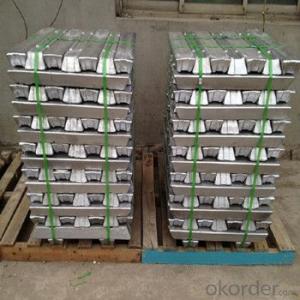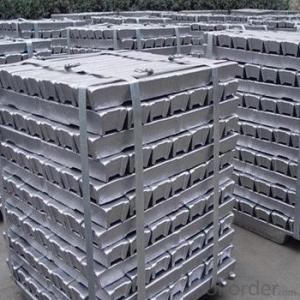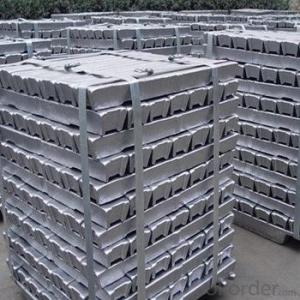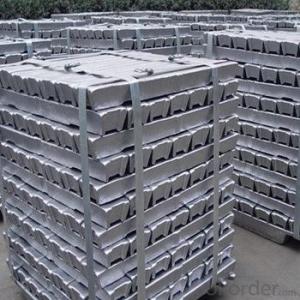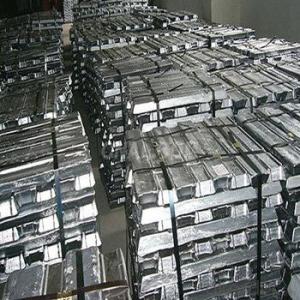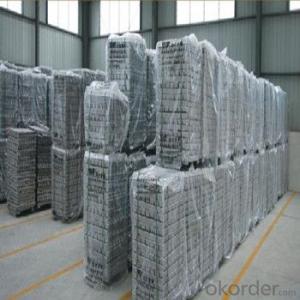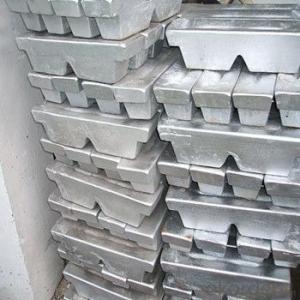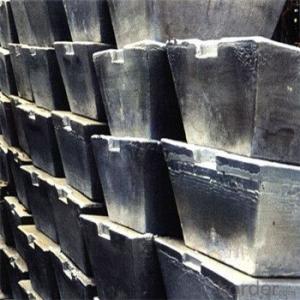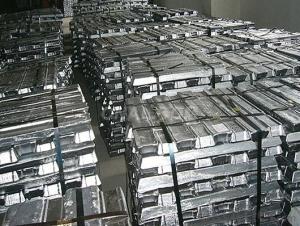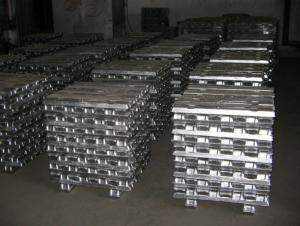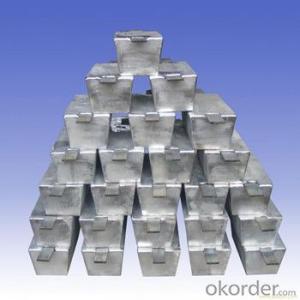Aluminum Pig/Ingot Sold With Low Price From Mills
- Loading Port:
- China main port
- Payment Terms:
- TT OR LC
- Min Order Qty:
- 1000 m.t.
- Supply Capability:
- 100000 m.t./month
OKorder Service Pledge
OKorder Financial Service
You Might Also Like
Pure Aluminum Pig/Ingot Used for Industry
1.Structure of Aluminum Pig/Ingot
A material that has been cast into a shape in order to be transported and processed easier than in an unprocessed form. An ingot is typically rectangular in shape, which allows it to be stacked. Ingots are most commonly associated with metals, with ingots of gold held in the vaults of banks and brokerages being popular images.
Aluminum Ingot is with the AL as the main chemical composition.Aluminum Ingot is used for industry,such as automobile,pinning and weaving,electron broadly and so on. Aluminum Ingot has the following advantages: easy control and operation, fast melting.
2.Main Features of the Aluminum Pig/Ingot
•High Purity
•Easy control and operation
•High strength
•Fast melting
•Competitive price
•Best Service
3.Aluminum Pig/Ingot Images


4.Aluminum Pig/Ingot Specification
Grade | Chemical Composition % | |||||||||
Al≥ | impurities ≤ | |||||||||
Si | Fe | Cu | Ga | Mg | Zn | Mn | others | Sum | ||
Al99.9 | 99.90 | 0.50 | 0.07 | 0.005 | 0.02 | 0.01 | 0.025 | - | 0.010 | 0.10 |
Al99.85 | 99.85 | 0.80 | 0.12 | 0.005 | 0.03 | 0.02 | 0.030 | - | 0.015 | 0.15 |
Al99.7 | 99.70 | 0.10 | 0.20 | 0.010 | 0.03 | 0.02 | 0.030 | - | 0.030 | 0.30 |
Al99.6 | 99.60 | 0.16 | 0.25 | 0.010 | 0.03 | 0.03 | 0.030 | - | 0.030 | 0.40 |
Al99.5 | 99.50 | 0.22 | 0.30 | 0.020 | 0.03 | 0.05 | 0.050 | - | 0.030 | 0.50 |
Al99.00 | 99.00 | 0.42 | 0.50 | 0.020 | 0.03 | 0.05 | 0.050 | - | 0.050 | 1.00 |
5.FAQ of Aluminum Pig/Ingot
We have organized several common questions for our clients,may help you sincerely:
①How about your company?
A professional factory which foucs on producing the aluminum pig,can meet customers' requiement to the quality and grade.The quality also have been accepted by customer.Already got the good reputation among the customers.It have gotten lot of much experience.The facrtory has the professional Technical Worker and the advanced equipments for production.Beside,it has the profesional teams to operate the whole proess for exporting.OEM service is availble and welcome.The items have beedn exported around the world,and have been acceptable among the customers,and have gotten the good reputation already.No matter from the quality,price and service,can be guaranteed for the cusgtomers.High purity and diffent grade are available.
②How to guarantee the quality of the products?
We have established the international advanced quality management system,every link from raw material to final product we have strict quality test;We resolutely put an end to unqualified products flowing into the market. At the same time, we will provide necessary follow-up service assurance.
③How long can we receive the prod rking days, We will arrange the factory delivery as soon as possible. The pecific time of receiving is related to the state and position of customers.Commonly 7 to 10 working days can be served.
- Q:How can aluminum cans be made into aluminium ingots?
- High temperature; persistent high temperature
- Q:How is the purity of an aluminum ingot determined?
- The purity of an aluminum ingot is typically assessed using various analytical techniques, with one of the most common methods being the utilization of a spectrometer to measure the elemental composition. This method, known as optical emission spectroscopy (OES) or spark testing, involves vaporizing a small sample of the ingot using an electric spark and analyzing the resulting emission of light. Each element emits a distinct spectrum of light, and by comparing the intensities of these spectral lines to known standards, the concentration of different elements in the ingot can be determined. This allows for the identification and quantification of impurities such as iron, copper, silicon, and other trace elements. Another approach to evaluating purity is through chemical analysis, which entails dissolving a sample of the ingot in an appropriate acid or solvent and conducting various chemical reactions to quantify the impurities. For instance, atomic absorption spectroscopy (AAS), a common technique, can be utilized to measure the concentration of specific elements in the solution. In addition to these analytical techniques, non-destructive tests like ultrasound or X-ray analysis can also be employed to assess the integrity and purity of the aluminum ingot. These methods are capable of detecting any internal flaws or inclusions that could potentially impact the quality of the ingot. In conclusion, a combination of these analytical techniques is employed to determine the purity of an aluminum ingot, ensuring that it meets the necessary specifications for diverse industrial applications.
- Q:How much is a ton of aluminum now?
- Different surface treatments, the aluminum price is not the same, and method of calculation is generally to aluminum price plus processing fees, the surrounding area of Pearl River Delta in the South China Sea is informed of aluminum ingot plus the processing fee price, accounting unit, and the Yangtze River Delta is the Yangtze River aluminum price, plus the processing fee accounting unit.
- Q:Can aluminum ingots be welded?
- Yes, aluminum ingots can be welded. Welding is the process of joining two or more pieces of metal together by melting and fusing them. Aluminum, being a widely used metal, can be welded using various welding techniques such as TIG (Tungsten Inert Gas) welding, MIG (Metal Inert Gas) welding, and even spot welding. However, it is important to note that welding aluminum requires specific knowledge and techniques due to its unique properties. Aluminum has a high thermal conductivity and a low melting point, which makes it susceptible to warping and distortion during the welding process. Therefore, proper preparation, selection of appropriate welding equipment and techniques, and the use of specific aluminum welding electrodes or filler metals are crucial to achieve successful welding results.
- Q:What is the role of aluminum ingots in the production of aircraft?
- Aircraft production heavily relies on aluminum ingots because of their unique properties and characteristics. In essence, aluminum ingots, which are blocks or bars of pure aluminum, serve as the primary raw material for making various components and structures in aircraft. The outstanding strength-to-weight ratio of aluminum ingots is one of the main reasons why they are preferred in aircraft production. Aluminum is a lightweight metal, making it perfect for aerospace applications where reducing weight is crucial for fuel efficiency and overall performance. By using aluminum ingots, manufacturers can create lightweight parts that contribute to reducing the overall weight of an aircraft. This leads to improved fuel economy and increased payload capacity. In addition, aluminum ingots possess remarkable corrosion resistance, even in harsh environments. This property is particularly important for aircraft as they are exposed to different atmospheric conditions, including moisture, salt, and pollutants. Aluminum's corrosion resistance helps ensure the durability and longevity of aircraft components, leading to reduced maintenance costs and enhanced safety. Furthermore, aluminum ingots are highly malleable and easily shaped, allowing manufacturers to form them into desired aircraft components through various manufacturing processes such as forging, extrusion, and machining. This versatility enables the production of complex parts, such as fuselage panels, wings, and landing gear, with precision and efficiency. Aside from their mechanical properties, aluminum ingots also exhibit excellent thermal conductivity. This characteristic is valuable in aircraft applications as it helps dissipate heat generated by engines, electronic systems, and other components. By efficiently transferring heat away from critical areas, aluminum contributes to the overall thermal management of an aircraft, enhancing performance and preventing overheating. In conclusion, aluminum ingots are essential in aircraft production due to their lightweight nature, corrosion resistance, malleability, and thermal conductivity. These properties enable the manufacturing of strong, durable, and efficient aircraft structures and components, which ultimately contribute to the safety, performance, and reliability of modern aircraft.
- Q:How can aluminium ingots be cast into aluminium plates?
- The composition of the aluminum plate is unchanged.
- Q:I want to melt aluminum scrap into aluminium ingots. How can I make them?
- The use of immersion smelting, that is, at least half of the aluminum water in the furnace, the mechanical aluminum into the aluminum water, aluminum water to cover the raw materials, reduce oxidation and burning.
- Q:What are the main factors influencing the choice between aluminum ingots and aluminum castings?
- The main factors influencing the choice between aluminum ingots and aluminum castings are the desired shape and complexity of the final product, manufacturing process efficiency, cost considerations, and the mechanical properties required for the application.
- Q:What are the different heat treatment processes for aluminum ingots?
- Enhancing the mechanical properties and overall performance of aluminum ingots can be achieved through various heat treatment processes. These processes encompass: 1. Annealing: By heating the aluminum ingot to a specific temperature and subsequently cooling it down gradually, internal stresses are relieved, ductility is improved, and machinability is enhanced. 2. Solutionizing: Also known as homogenization, this heat treatment process involves heating the aluminum ingot to a high temperature to dissolve any precipitates or impurities. It aims to create a more uniform microstructure and enhance the alloy's mechanical properties. 3. Quenching: Following solutionizing, quenching is a rapid cooling process that entails immersing the aluminum ingot in a quenching medium like water or oil to achieve quick cooling. Its purpose is to solidify the desired microstructure and enhance the alloy's strength and hardness. 4. Aging: Subsequent to solutionizing and quenching, aging is a heat treatment process where the aluminum ingot is heated at a moderate temperature for a specific duration to facilitate the precipitation of strengthening phases. This process bolsters the alloy's strength, hardness, and resistance against wear and corrosion. 5. Precipitation hardening: Also referred to as age hardening, precipitation hardening combines solutionizing, quenching, and aging. It encompasses heating the aluminum ingot to a high temperature to dissolve any precipitates, followed by rapid cooling and subsequent aging at a lower temperature. This process leads to the creation of a fine dispersion of precipitates within the alloy, resulting in improved strength and hardness. In conclusion, these heat treatment processes for aluminum ingots present a multitude of advantages, including enhanced mechanical properties, improved machinability, and augmented resistance against wear and corrosion. The selection of a specific treatment process depends on the desired properties and application of the aluminum alloy.
- Q:What are the basic equipments for the production of aluminium ingots?
- The most basic configuration: aluminum melting furnace, spectrum analyzer, forklift, loadometer, refining machine, casting machine is standard, if you really want to buy Artificial ingot casting province.
1. Manufacturer Overview |
|
|---|---|
| Location | |
| Year Established | |
| Annual Output Value | |
| Main Markets | |
| Company Certifications | |
2. Manufacturer Certificates |
|
|---|---|
| a) Certification Name | |
| Range | |
| Reference | |
| Validity Period | |
3. Manufacturer Capability |
|
|---|---|
| a)Trade Capacity | |
| Nearest Port | |
| Export Percentage | |
| No.of Employees in Trade Department | |
| Language Spoken: | |
| b)Factory Information | |
| Factory Size: | |
| No. of Production Lines | |
| Contract Manufacturing | |
| Product Price Range | |
Send your message to us
Aluminum Pig/Ingot Sold With Low Price From Mills
- Loading Port:
- China main port
- Payment Terms:
- TT OR LC
- Min Order Qty:
- 1000 m.t.
- Supply Capability:
- 100000 m.t./month
OKorder Service Pledge
OKorder Financial Service
Similar products
New products
Hot products
